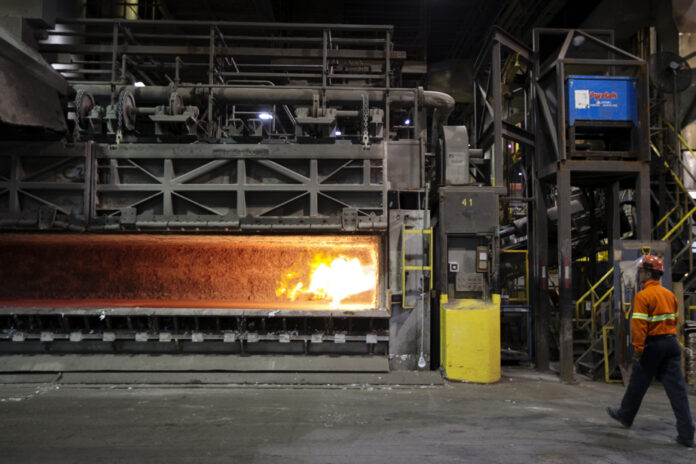Quebec’s aluminum smelters will get the extra energy at a good price that they demand, in exchange for an extra effort on their part to help Hydro-Quebec meet the demand for peak power, whose costs are exploding.
This “leadway” in negotiations with the Government of Quebec was mentioned on Wednesday by the executive director of Rio Tinto’s aluminum division, Sébastien Ross, who took part in a discussion on the future of the aluminum sector organized by the Montreal Council on International Relations, along with the managers of the two other aluminum smelters present in Quebec, Alcoa and Alouette.
This rare common output indicates that Quebec aluminum smelters are concerned about their future supply of clean, inexpensive electricity, at a time when Hydro-Quebec’s resources are limited and, above all, highly coveted by the battery and electric vehicle sector that the Legault government wants to develop.
The risk-sharing contracts concluded with Quebec end in 2029 and time is running out to obtain the government’s commitment that the energy that the aluminum smelters need to ensure their expansion will be available.
An agreement is close, however, according to what we can deduce from the words of the three leaders, with the key to an additional participation of the aluminum smelters to relieve the Hydro-Québec network when it is most in demand.
Rio Tinto, which has its own production facilities capable of currently meeting 90% to 95% of its electricity needs, is able to help Hydro-Quebec solve part of its peak problem, according to its leader.
“We have reservoirs and distribution lines connected to the Hydro-Quebec network. There is a way to jointly optimize our reservoirs,” explained Sébastien Ross, who believes that “fairly large volumes” of energy can be made available to Hydro-Québec without reducing plant production.
The production capacity of Rio Tinto’s hydroelectric network can also be increased. “As soon as we have an option to increase our production, we will do it,” he added.
Alcoa and Alouette, which operate the other aluminum smelters in Quebec, do not produce energy and do not have the same capacity to relieve the Hydro-Quebec network, but they also participate in the interruptible energy program used by Hydro -Quebec during periods of high demand. “We are absolutely open to optimizing the program,” said Claude Gosselin, President and CEO of Aluminerie Alouette.
Aluminum producers want to enter into risk-sharing contracts with the government like the ones that are coming to an end. “The formulas in place have proven themselves,” said the manager of Alouette. These contracts cause the price of electricity supplied by Hydro-Québec to vary according to the price of aluminum on the international market. Between 2014 and 2020, aluminum smelters thus paid less than Hydro-Québec’s current industrial rate (tariff L), which allowed Quebec plants to remain competitive on a global level, argued Jean Simard, the president of the Aluminum Association of Canada. “At Rate L, we would have lost pieces,” he said, pointing out that Hydro-Québec still makes profits with the aluminum smelters.
Alcoa Canada President Louis Langlois stressed that the price of electricity is a matter of life or death for aluminum smelters. “One cent per kilowatt hour more is an additional cost of $150 per ton. It equals the profit margin,” he illustrated.
The aluminum sector, which is the biggest emitter of greenhouse gases in Quebec, wants to become carbon neutral by 2050. It relies in particular on technology to achieve this, including that developed by Rio Tinto and Alcoa called Elysis. “The technology exists, now we have to reach the commercial level,” said the head of Rio Tinto. If Elysis demonstrates economic viability, commercial production could begin in 2026, he said.
Rio Tinto is leaning towards building new facilities to integrate its new technology, rather than converting existing facilities, said Sebastien Ross.
Aluminerie Alouette, of which Rio Tinto is a shareholder, has others who are also developing zero-emission technologies, said Claude Gosselin. This is particularly the case of the Norwegian Hydro Aluminium, which holds a 20% stake in the Sept-Îles plant.
Even if Hydro-Québec’s resources are limited, Québec does not have to choose between developing the battery sector and that of its aluminum sector. “It’s possible to do both,” says Jean Simard. According to him, Quebec can significantly increase its production of renewable energy to meet industrial demand, with new hydroelectric plants, wind or solar energy. The spokesperson for the aluminum industry says he is pleased with the openness shown by the new president of Hydro-Québec, Michael Sabia, regarding the increase in electricity production. In interviews he gave after his appointment, Mr. Sabia said he did not rule out any renewables, including nuclear.















